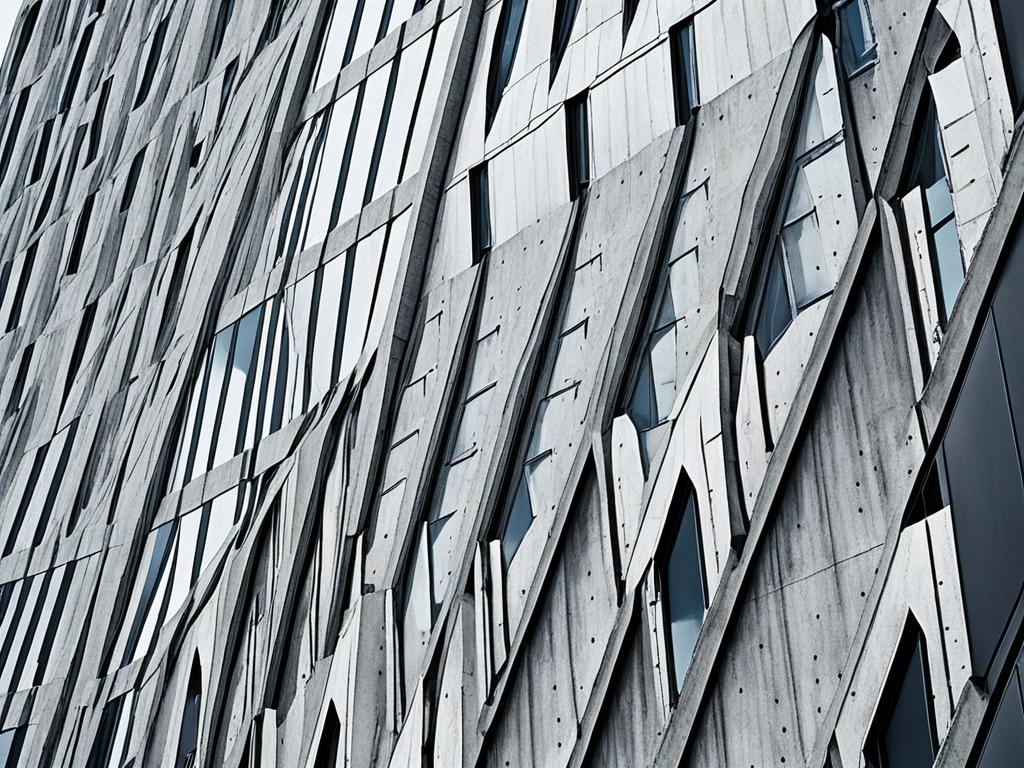Welcome to the fascinating world of Brutalism in Architecture. Whether you’re an architecture enthusiast or simply curious about the impact of concrete in design, this article will take you on a journey through the stark designs and rich history of Brutalism. Concrete reigns supreme in this architectural style, creating structures that make a bold statement.
Brutalism emerged in the mid-20th century and introduced a stark revolution in architectural aesthetics. Buildings in this style often display raw concrete exteriors, angular shapes, and a distinct lack of embellishments. The simplicity and boldness of these designs challenged the traditional notions of beauty in architecture.
Exploring the history and impact of Brutalism allows us to appreciate its significance in shaping the architectural landscape. From iconic structures that have become landmarks to lesser-known gems tucked away in cities around the world, the influence of Brutalism can be found far and wide.
Key Takeaways:
- Brutalism in architecture is characterized by stark designs and the prominent use of concrete.
- These structures brought a revolutionary aesthetic to the world of architecture.
- Notable Brutalist buildings exist in various locations worldwide, showcasing the impact and significance of this style.
- Brutalism has sparked controversy and criticism, with debates surrounding its aesthetic appeal, functionality, and social impact.
- Understanding the history and impact of Brutalism is essential in appreciating this unique architectural style.
The Stark Revolution
Brutalist buildings sparked a revolution in the world of architecture, challenging conventional norms and paving the way for a bold and unique aesthetic. These structures are defined by their defining characteristics that set them apart from other architectural styles.
One of the defining features of brutalist buildings is their emphasis on raw and exposed materials, with concrete reigning supreme. With its utilitarian nature and robust properties, concrete became the cornerstone of brutalist design. Its stark, unadorned appearance became synonymous with the movement, bringing forth a revolution in architectural expression.
But concrete alone does not define brutalism. These buildings are characterized by their bold and imposing forms, often showcasing geometric shapes and monolithic structures. The emphasis on mass and scale gives them a sense of power and dominance, while also serving functional purposes such as creating large open spaces and maximizing natural light.
Brutalist buildings also prioritize functionality and honesty in their design. Their exposed structural elements and lack of embellishments reflect an honest portrayal of the building’s purpose and construction. There are typically no decorative facades or unnecessary embellishments; these structures showcase the essential elements of their design.
Furthermore, brutalism is known for its “no-nonsense” approach, focusing on practicality rather than ornamentation. This stripped-down aesthetic seeks to eliminate any unnecessary distractions, leaving room for the form and function of the building to take center stage.
“Brutalism is attack architecture… it is devastatingly direct.” – Charles Jencks
Brutalist buildings brought a stark revolution in the world of architecture, challenging traditional notions of beauty and aesthetics. They pushed the boundaries of what was considered acceptable in design, often evoking strong emotions and polarizing opinions.
Defining Characteristics of Brutalist Buildings:
- Emphasis on raw and exposed materials, particularly concrete
- Bold and imposing forms, showcasing geometric shapes and monolithic structures
- Priority given to functionality and honesty in design
- Utilitarian and stripped-down aesthetic
The stark and uncompromising nature of brutalist buildings continues to captivate and divide opinions, making them a significant presence in the architectural landscape.
| Characteristics | Description |
|---|---|
| Raw and exposed materials | Brutalist buildings prioritize the use of raw materials, especially concrete, to showcase their unadorned and honest construction. |
| Bold and imposing forms | These structures often feature striking geometric shapes and large-scale structures, exuding a strong visual presence. |
| Functionality and honesty | Brutalist design prioritizes practicality and reveals the essential elements of the building’s purpose and construction. |
| Utilitarian aesthetic | The stripped-down and no-nonsense approach of brutalism emphasizes the building’s form and function over unnecessary embellishments. |
Notable Brutalist Structures Around the World
Brutalism in architecture has left a lasting impact on the global architectural landscape, with notable structures scattered across different continents. These buildings are a testament to the creativity and boldness of the Brutalist style, often characterized by its raw and rugged aesthetic created through the prominent use of exposed concrete.
One prominent example of Brutalist architecture is the Unité d’Habitation in Marseille, France. Designed by renowned architect Le Corbusier, this iconic residential building showcases the stark and utilitarian elements that define the style. Its imposing presence and innovative design have solidified its status as an architectural masterpiece.
The National Theatre in London, United Kingdom, is another noteworthy Brutalist structure. Designed by architect Denys Lasdun, this cultural venue stands out with its distinctive angular forms and textured concrete facades. The sensitivity to context and the integration of open public spaces make it an influential example of Brutalist architecture.
Concrete Cathedral, officially known as the Cathédrale Sainte-Marie de la Sede in Brasília, Brazil, is a striking Brutalist building designed by Oscar Niemeyer. Its monumental silhouette and organic curves exemplify the fusion of Brutalist aesthetics with modernist principles. The interplay of light and shadow cast by the unique concrete shell creates a captivating visual experience.
When discussing notable Brutalist structures, it is impossible to ignore Trellick Tower in London, United Kingdom. Designed by Ernő Goldfinger, this residential tower is a testament to the social ambition and functionalism often associated with Brutalism. Its imposing height and distinctive exterior serve as a visual landmark, with its architectural significance recognized through its Grade II* listed status.
Heading to the Americas, Boston City Hall in Massachusetts, United States, stands as a controversial yet prominent example of Brutalist architecture. Designed by Kallmann McKinnell & Knowles, this architectural marvel showcases rugged concrete facades, bold shapes, and an open plaza. Its innovative design and civic significance make it an important contributor to the urban fabric of the city.
The Museu de Arte de São Paulo (MASP) in São Paulo, Brazil, is hailed for its distinctive suspended design that defies gravity. The architectural vision of Lina Bo Bardi is evident in the museum’s large-span interior, creating a visually stunning space. The combination of concrete and glass imbues the structure with a sense of transparency and modernity.
The examples mentioned above represent just a glimpse of the remarkable Brutalist structures that can be found around the world. Each building pushes the boundaries of design, challenging conventional ideas of architecture and leaving an indelible mark on the urban fabric. Exploring these notable structures provides insight into the diverse interpretations and cultural influences that have shaped Brutalist architecture.
The Controversy and Criticism of Brutalism
While Brutalism in architecture has enjoyed a loyal following, it has also attracted its fair share of controversy and criticism. The bold and stark designs that define Brutalist buildings have often polarized opinions, eliciting both admiration and disdain.
One of the main points of contention revolves around the aesthetic appeal of Brutalist structures. Critics argue that their imposing and utilitarian nature clashes with more traditional architectural styles, lacking the grace and elegance typically associated with buildings. The controversy and criticism of brutalism stems from the visual impact these structures have on the urban landscape, with some viewing them as eyesores that disrupt the harmony of their surroundings.
Functionality is another area that attracts criticism. While Brutalist buildings were often designed with a focus on functionality and practicality, some argue that the use of raw concrete and the lack of attention to details can result in spaces that feel cold and unwelcoming. These buildings have been criticized for their lack of human scale and their failure to create engaging environments for their occupants.
Furthermore, the social impact of Brutalism has also been a point of contention. Although originally intended to bring about social change and promote equality through accessible and affordable housing, some argue that Brutalist developments have failed in their social objectives. The large scale and massiveness of these buildings can create a sense of alienation and erode the fabric of communities.
Despite the controversy and criticism surrounding Brutalism, it is essential to acknowledge the movement’s unique approach and its contribution to architectural history. The controversy and criticism of brutalism should be seen in the context of the time when these structures were built, with their unconventional designs challenging the status quo and pushing boundaries.
Brutalism, with all its flaws and imperfections, sparked important debates about the purpose and role of architecture in society. It forces us to question our preconceived notions of beauty and challenges us to redefine what constitutes good design.
By understanding the controversies and criticisms, we can better appreciate the significance and impact of Brutalism in architecture. It serves as a reminder that architecture is not simply about aesthetics but also about engaging with the social, political, and cultural contexts in which it exists.
Next, let’s explore some notable Brutalist structures from around the world, showcasing the diversity and influence of this architectural style.
Famous Brutalist Buildings and their Architects
| Building | Architect |
|---|---|
| Smithsonian National Air and Space Museum | Gordon Bunshaft |
| Trellick Tower, London | Ernő Goldfinger |
| Centre Georges Pompidou, Paris | Renzo Piano and Richard Rogers |
| Robarts Library, University of Toronto | Mathers & Haldenby Architects |
| Unité d’Habitation, Marseille | Le Corbusier |
Conclusion
In conclusion, Brutalism in Architecture has left an indelible mark on the architectural world. This unique style, characterized by its bold use of concrete and stark designs, has challenged the traditional norms of architecture, ushering in a stark revolution.
Throughout this article, we have explored the defining characteristics of Brutalist buildings and showcased notable examples from around the world. From the iconic Barbican Estate in London to the striking Boston City Hall, these structures have captured the attention and sparked both admiration and controversy.
While Brutalism faces criticism for its imposing aesthetics and perceived lack of warmth, it cannot be denied that it has made a significant impact. Understanding the history and significance of Brutalism is crucial in appreciating its contribution to the architectural landscape.
Whether you love it or hate it, Brutalism in Architecture will continue to be a topic of fascination and debate. Its legacy as a challenging and thought-provoking architectural style will endure, reminding us of the power of design to evoke strong emotions and shape our built environment.







